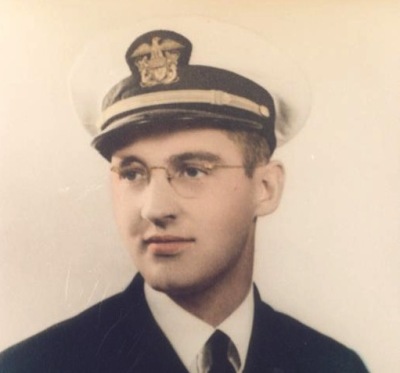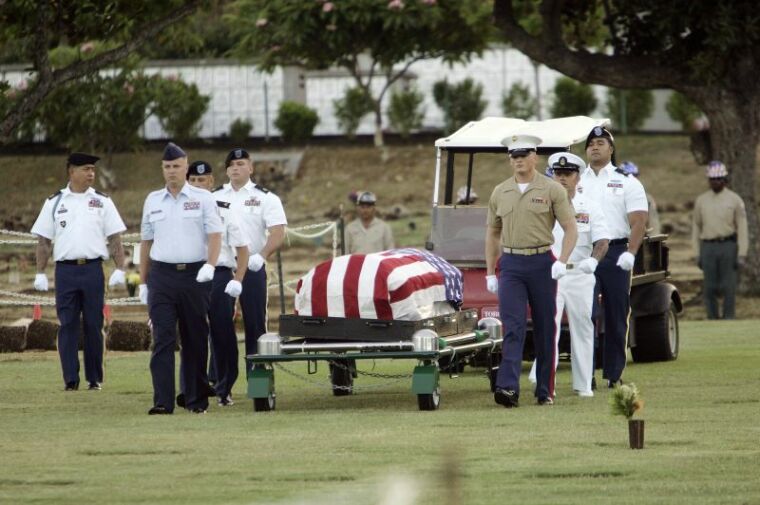DNA used to identify Pearl Harbor chaplain after 75 years
PEARL HARBOR, Hawaii (Christian Examiner) – With a few more tugs through a porthole, Chaplain (Lt. j.g.) Aloysius Schmitt might have been yanked free from the capsized USS Oklahoma on Dec. 7, 1941, but the 31-year-old Navy chaplain told the sailors trying to pull him free to stop.
Schmitt insisted there was no time to keep trying. He demanded they push him back in the ship. They did and for the remainder of his time on earth he said prayers as other, smaller sailors took their turn trying to squeeze through.
Twelve more sailors passed through the opening before the compartment filled with water.
DAY OF INFAMY
Dec. 7, 1941, was a Sunday morning, which means it was a busy day for chaplains like Schmitt. That morning, he woke up early and prepared for the Mass. A few minutes after the Mass had ended, the thump of bombs outside the ship could be heard.
The surprise Japanese attack on an entire fleet at anchor was underway.
Within minutes, four torpedoes had ruptured the Oklahoma's belly. The rush of water into the ship sent sailors scrambling for higher decks, only to have their escape confused and cut short when the ship rolled on its side.
Schmitt was among them, but survivors relayed stories of the Catholic priest's calm and his assurances that all would be well in the end. For 429 aboard the Oklahoma, it was not.

For his actions, Chaplain Schmitt was awarded the Navy and Marine Corps Medal and the Purple Heart, and in 1943 the Navy christened one of his destroyers the "USS Schmitt" in his honor.
Schmitt and those left behind aboard the ship were eventually recovered when the ship was righted, but the decomposition of the bodies left a tangled mass of bones, dog tags, uniforms and personal belongings. Among them was the chaplain's prayer book, the ribbon already placed on the reading for Dec. 8:
"Oh Lord, Our Lord, How great is your name in all the earth" (Psalm 8:1).
Only a few of the bodies were positively identified. The rest were placed in caskets and buried in 1944 in graves marked "Unknown." They were exhumed in 1947 in a last ditch effort to identify them with the scientific tools available at the time. The effort proved futile and by 1950, the remains were again placed in caskets and returned to the ground.
Then, in 2003 and 2007, modern DNA testing was employed on the human remains in two of the caskets. From those efforts, six crewmen were identified. That led the Defense Department to exhume the remaining caskets and try again to identify the 388 still missing in 2015.
On Sept. 5, notification officers with the military arrived at the home of Art and Dorothy Schultz in Milford, Iowa. Dorothy is Chaplain Schmitt's oldest living niece and the "primary next of kin."
The officers told her that the chaplain's remains had been positively identified through DNA analysis and would be transported to the Archdiocese of Dubuque. His coffin, draped with an American flag, will arrive in time for a burial mass at St. Luke's, the chaplain's home parish, on Oct. 5. Following another service at Loras College, where the chaplain's prayer book is currently located, his remains will be buried with military honors.
A GENTLE FARM BOY
Schmitt was born in 1909 and grew up on a farm with nine siblings. He rode the family's horse to Mass daily and went on to enter the priesthood after graduating from Loras College in 1932. He studied in Rome and was ordained to the ministry in 1935. After serving churches in Iowa and Wyoming, he requested endorsement as a Catholic chaplain in the Navy.

He was assigned to the USS Oklahoma in 1940.
Steve Sloan is Schmitt's great-nephew. He never had the opportunity to meet the chaplain, but said family members relayed that he was a "gentle, soft-spoken man" with a "witty sense of humor that drew people to him."
"By all accounts, he was very well respected by the sailors of his ship, both Catholic and non-Catholic alike," Sloan told the Catholic Herald.
Sloan and his wife, Julie, were at the home in Milford when the notification was made.
"It really hit home for me during that family visit," Sloan, who helped contact other relatives with the news, told the paper.
"I knew I was witnessing a historical moment. I thought to myself, 'This is the final chapter in Father Al's journey. We'll truly be bringing him home. We'll finally be able to do something special for this incredible man,'" Sloan said.

